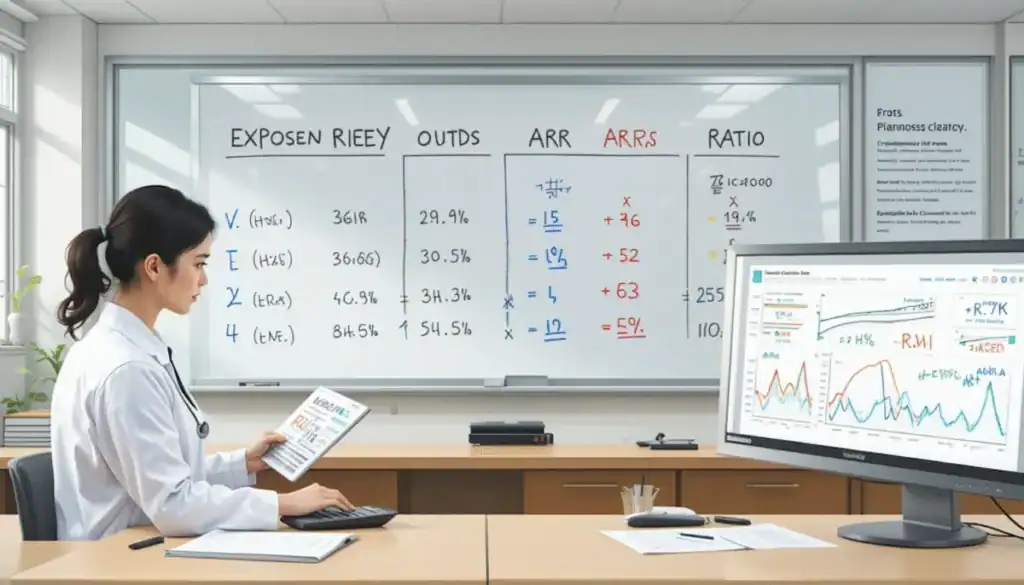Understanding risk calculations is essential in epidemiology and biostatistics, especially when interpreting research studies. In this post, we break down the most important concepts: odds ratio, risk ratio (relative risk), attributable risk (AR), absolute risk reduction (ARR), and how to interpret them using simple tables and examples.
🧮 The Foundation: The 2×2 Table
Every biostatistical calculation begins with the 2×2 contingency table. It is structured as:
| Outcome Positive | Outcome Negative | |
|---|---|---|
| Exposure (+) | A | B |
| Exposure (−) | C | D |
Example: Smoking (exposure) vs. Lung Cancer (outcome)
- A = Smokers who developed lung cancer
- B = Smokers who did not develop lung cancer
- C = Non-smokers who developed lung cancer
- D = Non-smokers who did not develop lung cancer
🔁 Odds Ratio (OR)
Used in case-control studies.
Formula:
OR=A×DB×C\text{OR} = \frac{A \times D}{B \times C}OR=B×CA×D
Example:
- Exposed = 2500 (1500 diseased, 1000 healthy)
- Unexposed = 2500 (500 diseased, 2000 healthy)
OR=1500×20001000×500=3,000,000500,000=6\text{OR} = \frac{1500 \times 2000}{1000 \times 500} = \frac{3,000,000}{500,000} = 6OR=1000×5001500×2000=500,0003,000,000=6
Interpretation: People exposed to the carcinogen are 6 times more likely to develop lung cancer compared to unexposed.
📊 Risk Ratio (Relative Risk – RR)
Used in cohort studies where participants are followed over time.
Formula: RR=A/(A+B)C/(C+D)\text{RR} = \frac{A / (A + B)}{C / (C + D)}RR=C/(C+D)A/(A+B)
Example:
- Exposed: 300 (90 ill)
- Unexposed: 200 (30 ill)
RR=90/30030/200=0.3/0.15=2\text{RR} = \frac{90/300}{30/200} = 0.3 / 0.15 = 2RR=30/20090/300=0.3/0.15=2
Interpretation: Risk of disease is 2 times higher in exposed group.
🔍 Interpretation of OR and RR
- = 1 → No association (neutral risk)
- > 1 → Exposure increases risk (potentially harmful)
- < 1 → Exposure decreases risk (potentially protective)
🧾 Attributable Risk (AR) vs. Absolute Risk Reduction (ARR)
Both reflect the difference in risk between two groups but are used in different contexts.
| Term | Used For | Formula | Meaning |
|---|---|---|---|
| AR | Harmful exposures | AA+B−CC+D\frac{A}{A+B} – \frac{C}{C+D}A+BA−C+DC | Risk added by exposure (e.g. smoking) |
| ARR | Beneficial interventions | CC+D−AA+B\frac{C}{C+D} – \frac{A}{A+B}C+DC−A+BA | Risk reduced by treatment (e.g. a drug) |
🧪 Example: Attributable Risk
- Smokers: 200 (80 cough cases)
- Non-smokers: 300 (30 cough cases)
AR=80200−30300=0.4−0.1=0.3\text{AR} = \frac{80}{200} – \frac{30}{300} = 0.4 – 0.1 = 0.3AR=20080−30030=0.4−0.1=0.3
30% of chronic cough cases in smokers can be attributed to smoking.
💊 Example: Absolute Risk Reduction
- Treatment group: 1000 (50 heart attacks)
- Control group: 1000 (150 heart attacks)
ARR=1501000−501000=0.15−0.05=0.1\text{ARR} = \frac{150}{1000} – \frac{50}{1000} = 0.15 – 0.05 = 0.1ARR=1000150−100050=0.15−0.05=0.1
The drug reduced heart attack risk by 10%.
🧠 Easy Tip to Remember
👉 Always subtract the smaller risk from the larger one.
👉 If it’s a treatment, it’s ARR.
👉 If it’s a toxin/harmful exposure, it’s AR.
📉 Attributable Risk Percentage (AR%)
Shows what percent of the total risk is due to the exposure.
Formula: \text{AR%} = \left( \frac{\text{AR}}{\text{Risk in exposed}} \right) \times 100
Example (smoking): AR=0.3,Risk in smokers=0.4AR%=0.30.4×100=75%\text{AR} = 0.3,\quad \text{Risk in smokers} = 0.4 \quad \text{AR\%} = \frac{0.3}{0.4} \times 100 = 75\%AR=0.3,Risk in smokers=0.4AR%=0.40.3×100=75%
75% of cough risk among smokers is due to smoking.
🎯 Key Takeaways
- Case-control studies → Use Odds Ratio (OR)
- Cohort studies → Use Risk Ratio (RR)
- Attributable Risk (AR) → Toxins/carcinogens
- Absolute Risk Reduction (ARR) → Treatments/interventions
- AR% → Shows how much of the risk is actually caused by exposure
📸 Ultra-Realistic Visual Summary
This article simplifies one of the most feared parts of biostats. Practice creating the 3×2 table, understand the logic, and you’ll master these calculations in no time.
Stay tuned for the next lecture in our Epidemiology and Biostats Series!



